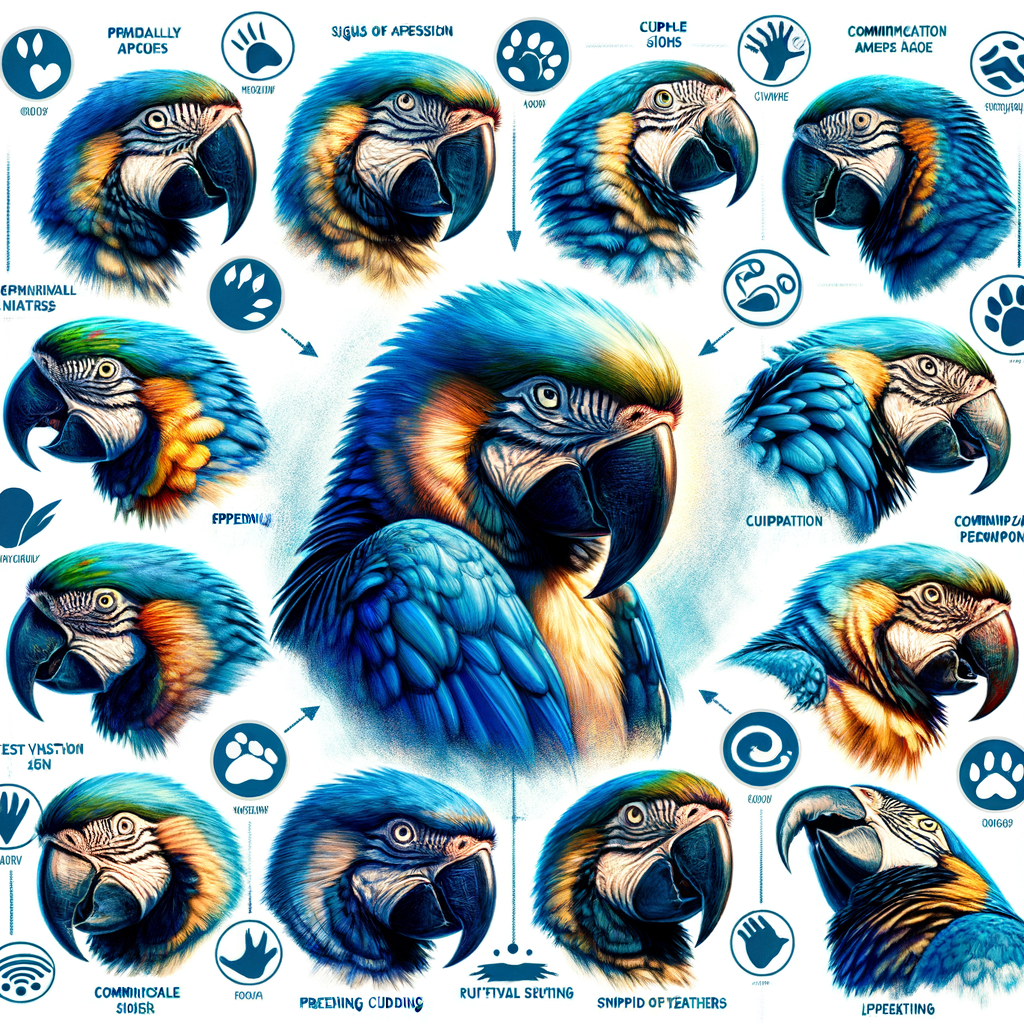
Introduction to Macaw Behavior
Macaws are vibrant, intelligent, and social creatures, known for their bright colors and loud vocalizations. They are a popular choice for pet owners due to their playful nature and ability to mimic human speech. However, understanding their behavior is crucial for a harmonious relationship with these exotic birds.
- Overview of Macaw Pet Behavior
- Importance of Understanding Macaw Behavior Patterns
Macaws are highly social birds that thrive on interaction and stimulation. They are known for their playful behavior, which includes swinging from perches, playing with toys, and engaging in games of chase. Macaws are also vocal birds, often using loud squawks and screams to communicate with their owners and express their emotions.
One of the most fascinating aspects of Macaw behavior is their ability to mimic human speech. This is not just a parlor trick, but a sign of their intelligence and social nature. They use this ability to communicate with their human companions, often learning words and phrases that they associate with certain actions or emotions.
Understanding the behavior patterns of your Macaw is essential for providing them with a healthy and happy environment. Their behavior can give you insights into their emotional state and alert you to potential health issues. For instance, a sudden change in behavior, such as increased aggression or decreased activity, could be a sign of stress or illness.
By observing and understanding your Macaw’s behavior, you can also learn how to interact with them in a way that respects their natural instincts and promotes a strong bond. For example, Macaws are naturally curious and love to explore their environment. Providing them with plenty of toys and opportunities for exploration can help satisfy this instinct and prevent boredom and destructive behavior.
In conclusion, understanding your Macaw’s behavior is not just about managing their actions, but about building a strong, respectful, and loving relationship with your feathered friend. By taking the time to learn about their behavior patterns, you can ensure that your Macaw feels safe, loved, and stimulated in their home environment.
Understanding Macaw Body Language
Macaws, like many other birds, communicate primarily through their body language. Understanding this language is key to building a strong and healthy relationship with your pet macaw. In this section, we will delve into the basics of macaw communication and how to interpret their behavior.
Macaw Communication Basics
Macaws use a variety of signals to communicate their feelings and intentions. These signals can be broadly divided into two categories: vocal and physical. Vocal signals include different types of squawks, screams, and chatter, while physical signals involve movements and postures.
- Understanding Macaw bird language: Macaws have a rich vocal language. They can mimic human speech and other sounds, but they also have their own unique sounds. For example, a low, soft chatter usually indicates contentment, while a loud, high-pitched scream can be a sign of fear or excitement. Learning to recognize these sounds can help you understand what your macaw is trying to communicate.
- Interpreting Macaw behavior: Macaws also communicate through their behavior. For instance, a macaw that is fluffing up its feathers and bobbing its head is likely excited or happy. On the other hand, a macaw that is crouching with its feathers slicked down and beak open may be scared or defensive. Observing your macaw’s behavior closely can give you valuable insights into its mood and feelings.
Understanding your macaw’s body language is a skill that develops over time. It requires patience, observation, and a willingness to learn. Remember, every macaw is unique and may have its own special ways of communicating. The more time you spend with your macaw, the better you will become at understanding its body language.
Macaw Emotional Signs
Understanding the emotional signs of your Macaw can greatly enhance your bond with your feathered friend. Macaws, like humans, have a range of emotions and they express these emotions in different ways. Let’s explore some of the common emotional signs of a Macaw.
- Recognizing Happy Macaw Signs
- Identifying Macaw Signs of Stress
When a Macaw is happy, it will display a number of signs. One of the most common signs is a relaxed body posture. The bird will often fluff up its feathers, stretch out its wings and tail, and may even start to preen. A happy Macaw will also be more vocal and active, engaging in playful activities like swinging, climbing, and exploring its surroundings.
Another sign of a happy Macaw is its eyes. Macaws have a unique ability to control the size of their pupils, a behavior known as “pinning.” When a Macaw is excited or happy, you may notice its pupils rapidly expanding and contracting.
Just as it’s important to recognize when your Macaw is happy, it’s equally important to identify signs of stress. A stressed Macaw may display behaviors such as feather plucking, loss of appetite, or a change in droppings. They may also become more aggressive or start to withdraw from social interactions.
Physical signs of stress in a Macaw can include ruffled feathers, panting, and a change in body posture. If you notice any of these signs, it’s crucial to identify the source of the stress and take steps to alleviate it. This could involve making changes to the bird’s environment, diet, or daily routine.
Understanding your Macaw’s emotional signs is a key part of building a strong and healthy relationship with your bird. By paying close attention to these signs, you can ensure that your Macaw is happy, healthy, and stress-free.
Macaw Signs of Affection
Macaws, like many other pets, have unique ways of showing their affection. Understanding these signs can help you build a stronger bond with your feathered friend. Let’s delve into some of the positive behavior patterns that indicate your Macaw’s affection.
Positive Macaw Behavior Patterns
Macaws exhibit several behaviors that signal their affection. These behaviors can be subtle, so it’s important to pay close attention to your bird’s actions. Here are a few examples:
- Beak Grinding: This is a common behavior among Macaws when they are content and relaxed. It’s a sign that your bird feels safe and comfortable in your presence.
- Regurgitation: While it may not sound appealing, a Macaw regurgitating for its owner is a sign of affection. In the wild, Macaws do this to feed their young and mates.
- Preening: If your Macaw gently nibbles or preens your hair or skin, it’s a sign of affection. They are grooming you, just as they would do to a mate or a close companion in the wild.
Now, let’s look at a case study that highlights Macaw bonding behavior.
Case Study: Macaw Bonding Behavior
In a study conducted by the University of Cambridge, a pair of Macaws were observed over a period of six months. The researchers noted that the birds exhibited a significant amount of affectionate behaviors, including mutual preening and sharing of food. This behavior increased over time, indicating a strengthening bond between the pair.
This case study demonstrates the capacity of Macaws to form strong, affectionate bonds. It also underscores the importance of understanding and responding to your Macaw’s affectionate behaviors to foster a deeper connection.
How to Encourage Affectionate Behavior in Macaws
Encouraging affectionate behavior in Macaws involves two key steps: creating a safe and comfortable environment, and building trust with your Macaw. Let’s delve into each of these steps in detail.
- Creating a Safe and Comfortable Environment
- Building Trust with Your Macaw
Macaws, like all birds, need a safe and comfortable environment to thrive. This involves providing them with a spacious cage, a balanced diet, and plenty of toys for mental stimulation. The cage should be large enough for your Macaw to stretch its wings and move around comfortably. It should also be placed in a quiet, low-traffic area of your home to minimize stress.
Feeding your Macaw a balanced diet is also crucial. This should include a mix of fruits, vegetables, and bird-safe seeds. Avoid feeding your Macaw foods that are toxic to birds, such as avocados and chocolate.
Lastly, provide your Macaw with plenty of toys to keep it mentally stimulated. This can include puzzle toys, chew toys, and toys that encourage foraging behavior.
Building trust with your Macaw is a gradual process that requires patience and consistency. Start by spending time near your Macaw’s cage each day, talking softly to it and offering it treats from your hand. This will help your Macaw get used to your presence and associate you with positive experiences.
Once your Macaw is comfortable with your presence, you can start to gently handle it. Always move slowly and calmly to avoid frightening your Macaw. Over time, your Macaw will learn to trust you and may even start to show affectionate behavior, such as preening you or cuddling against you.
In conclusion, encouraging affectionate behavior in Macaws involves creating a safe and comfortable environment and building trust with your bird. By following these steps, you can foster a strong bond with your Macaw and enjoy a rewarding relationship with this intelligent and affectionate bird.
Macaw Signs of Aggression
Understanding the signs of aggression in Macaws is crucial for maintaining a healthy and safe environment for both you and your pet. Aggression in Macaws can be displayed in various ways, and recognizing these signs early can help manage and even prevent aggressive behavior.
Recognizing Aggressive Macaw Behavior
Macaws, like any other pets, can exhibit signs of aggression. It’s important to recognize these signs early to prevent any harm to you or your pet.
- Common signs of aggression in Macaws
- Loud and repetitive squawking
- Feather plucking or self-mutilation
- Biting or nipping
- Flaring tail feathers
- Pinning eyes (rapidly dilating and constricting pupils)
- Case study: Dealing with aggressive Macaw behavior
Aggressive behavior in Macaws can manifest in several ways. Some of the most common signs include:
These signs can be a result of various factors such as stress, boredom, fear, or illness. It’s essential to monitor your Macaw’s behavior closely and seek professional help if these signs persist.
Consider the case of ‘Polly’, a Blue and Gold Macaw. Polly began showing signs of aggression, such as biting and loud squawking. Her owner, concerned about these changes, sought professional help. The bird specialist identified that Polly was bored and stressed due to lack of stimulation and interaction. By introducing new toys, more interaction, and a varied diet, Polly’s aggressive behavior significantly reduced. This case highlights the importance of understanding and responding to your Macaw’s needs to manage and prevent aggressive behavior.
Recognizing and understanding your Macaw’s aggressive behavior is the first step in managing it. In the next section, we will discuss techniques for calming an aggressive Macaw and when to seek professional help.
How to Manage Aggressive Behavior in Macaws
Managing aggressive behavior in Macaws can be challenging, but with the right techniques and understanding, it can be achieved. Here are some steps to follow:
- Techniques for calming an aggressive Macaw
- Positive Reinforcement: Reward your Macaw for good behavior. This can be done by giving them their favorite treat or toy. This encourages them to repeat the good behavior.
- Consistent Routine: Macaws thrive on routine. Keeping a consistent schedule for feeding, playtime, and sleep can help reduce stress and aggression.
- Safe Space: Ensure your Macaw has a safe and comfortable space to retreat to when they feel threatened or stressed.
- Training: Regular training sessions can help manage aggressive behavior. Use simple commands and reward them for following instructions.
- When to seek professional help
- Your Macaw’s aggressive behavior is causing harm to themselves or others.
- There is a sudden change in their behavior.
- Your Macaw is showing signs of stress or illness.
- You feel overwhelmed and unable to manage your Macaw’s behavior.
Macaws, like any other pets, require patience and understanding. If your Macaw is showing signs of aggression, here are some techniques you can use to calm them down:
If your Macaw’s aggressive behavior continues despite your best efforts, it may be time to seek professional help. A professional bird trainer or a vet can provide guidance and help manage your Macaw’s behavior. Here are some signs that it’s time to seek professional help:
Remember, every Macaw is unique and what works for one might not work for another. Patience, understanding, and consistency are key in managing aggressive behavior in Macaws.
Conclusion: Enhancing Your Relationship with Your Macaw
As we conclude this insightful journey into the world of Macaws, it’s important to remember that understanding your feathered friend’s behavior is key to building a strong, healthy relationship with them. Let’s summarize the key takeaways and final thoughts on the importance of interpreting Macaw behavior.
- Key takeaways on understanding and managing Macaw behavior
- Final thoughts on the importance of interpreting Macaw behavior
Understanding Macaw behavior starts with recognizing their body language. A relaxed Macaw will have its feathers smooth, eyes wide and beak closed. On the other hand, a Macaw that’s scared or aggressive might fluff its feathers, squawk loudly, or even bite.
Macaws show affection in various ways, such as preening, sharing food, or simply spending time near you. Recognizing these signs can help you respond appropriately, strengthening your bond with your Macaw.
Aggressive behavior in Macaws, like biting or screaming, is often a sign of stress or discomfort. It’s crucial to identify the cause of this behavior and address it promptly to ensure your Macaw’s well-being.
Interpreting Macaw behavior is not just about understanding what your pet is trying to communicate, but also about ensuring their physical and emotional health. A happy, healthy Macaw is more likely to engage in positive behaviors and less likely to show signs of aggression or fear.
Remember, building a strong relationship with your Macaw takes time and patience. But with a little effort and understanding, you can enhance your bond with your feathered friend, making your time together more enjoyable and rewarding.
In conclusion, understanding and interpreting your Macaw’s behavior is a continuous learning process. But the rewards of a strong, loving relationship with your Macaw are well worth the effort. So, keep observing, keep learning, and keep loving your Macaw!






